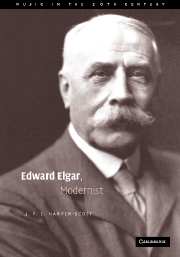Book contents
- Frontmatter
- Contents
- Preface
- 1 Styles and ideas
- 2 A Heideggerian refinement of Schenker's theory
- 3 Immuring and immured tonalities: tonal malaise in the First Symphony, Op. 55
- 4 ‘Fracted and corroborate’: narrative implications of form and tonality in Falstaff, Op. 68
- 5 Hermeneutics and mimesis
- 6 The annihilation of hope and the unpicking of identity: Elgarian hermeneutics
- 7 Modern music, modern man
- Glossary
- Bibliography
- Index
4 - ‘Fracted and corroborate’: narrative implications of form and tonality in Falstaff, Op. 68
Published online by Cambridge University Press: 03 May 2010
- Frontmatter
- Contents
- Preface
- 1 Styles and ideas
- 2 A Heideggerian refinement of Schenker's theory
- 3 Immuring and immured tonalities: tonal malaise in the First Symphony, Op. 55
- 4 ‘Fracted and corroborate’: narrative implications of form and tonality in Falstaff, Op. 68
- 5 Hermeneutics and mimesis
- 6 The annihilation of hope and the unpicking of identity: Elgarian hermeneutics
- 7 Modern music, modern man
- Glossary
- Bibliography
- Index
Summary
The nature, subject, and intent of a symphonic study
Falstaff is curious: an amalgam of literature and music, it is not necessarily limited by either the narrative structures of the one or the syntactic structures of the other. Elgar does not call Falstaff a symphonic- or tone poem, but its similarities to the Lisztian/Straussian genre are obvious and central. James Hepokoski defines the musicologist's task in analyzing such a piece in an article on Don Juan:
The essence of a symphonische Dichtung is situated in the listener's act (anticipated by the composer's) of connecting text and paratext, music and non-musical image, and grappling with the implications of the connection. The genre exists, qua genre, solely within the receiver, who agrees to create it reciprocally by indicating his or her willingness to play the game proposed by the composer; it does not exist abstractly in the acoustical surface of the music. Consequently, by the rules of the symphonic-poem game, we are not permitted to ask whether we could deduce the proper images had we not been supplied with them in advance, or had we not at least been given some broad hints in their direction. If we wish to play, we must abide by the rules; otherwise we are playing a different game or redefining the original one to suit our own purposes.
It is interesting that Tovey's 1932 analysis of Falstaff was written before he had read Elgar's own 1913 article.
- Type
- Chapter
- Information
- Edward Elgar, Modernist , pp. 107 - 153Publisher: Cambridge University PressPrint publication year: 2006



